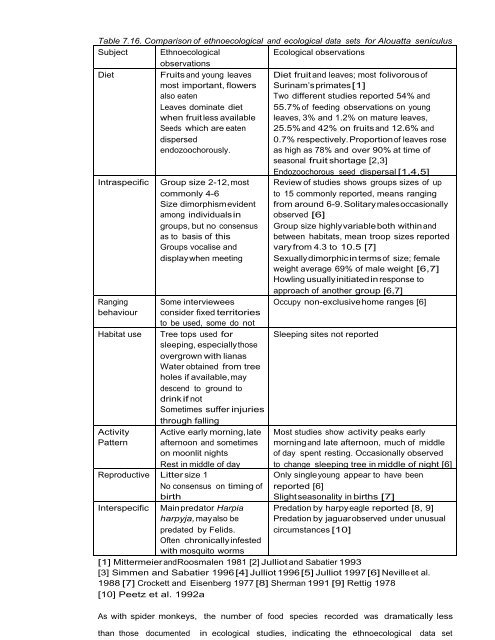Ethnoecology, Resource Use, Conservation And Development In A ...
Ethnoecology, Resource Use, Conservation And Development In A ...
Ethnoecology, Resource Use, Conservation And Development In A ...
Create successful ePaper yourself
Turn your PDF publications into a flip-book with our unique Google optimized e-Paper software.
Table 7.16. Comparison of ethnoecological and ecological data sets for Alouatta seniculus<br />
Subject Ethnoecological<br />
observations<br />
Ecological observations<br />
Diet Fruits and young leaves Diet fruit and leaves; most folivorous of<br />
most important, flowers Surinam’s primates [1]<br />
also eaten<br />
Two different studies reported 54% and<br />
Leaves dominate diet 55.7% of feeding observations on young<br />
when fruit less available leaves, 3% and 1.2% on mature leaves,<br />
Seeds which are eaten 25.5% and 42% on fruits and 12.6% and<br />
dispersed<br />
0.7% respectively. Proportion of leaves rose<br />
endozoochorously.<br />
as high as 78% and over 90% at time of<br />
seasonal fruit shortage [2,3]<br />
Endozoochorous seed dispersal [1,4,5]<br />
<strong>In</strong>traspecific Group size 2-12, most Review of studies shows groups sizes of up<br />
commonly 4-6<br />
to 15 commonly reported, means ranging<br />
Size dimorphism evident from around 6-9. Solitary males occasionally<br />
among individuals in observed [6]<br />
groups, but no consensus Group size highly variable both within and<br />
as to basis of this<br />
between habitats, mean troop sizes reported<br />
Groups vocalise and vary from 4.3 to 10.5 [7]<br />
display when meeting Sexually dimorphic in terms of size; female<br />
weight average 69% of male weight [6,7]<br />
Howling usually initiated in response to<br />
approach of another group [6,7]<br />
Ranging Some interviewees Occupy non-exclusive home ranges [6]<br />
behaviour consider fixed territories<br />
to be used, some do not<br />
Habitat use Tree tops used for<br />
sleeping, especially those<br />
overgrown with lianas<br />
Water obtained from tree<br />
holes if available, may<br />
descend to ground to<br />
drink if not<br />
Sometimes suffer injuries<br />
through falling<br />
Sleeping sites not reported<br />
Activity Active early morning, late Most studies show activity peaks early<br />
Pattern afternoon and sometimes morning and late afternoon, much of middle<br />
on moonlit nights<br />
of day spent resting. Occasionally observed<br />
Rest in middle of day to change sleeping tree in middle of night [6]<br />
Reproductive Litter size 1<br />
Only single young appear to have been<br />
No consensus on timing of reported [6]<br />
birth<br />
Slight seasonality in births [7]<br />
<strong>In</strong>terspecific Main predator Harpia Predation by harpy eagle reported [8, 9]<br />
harpyja, may also be Predation by jaguar observed under unusual<br />
predated by Felids.<br />
Often chronically infested<br />
with mosquito worms<br />
circumstances [10]<br />
[1] Mittermeier and Roosmalen 1981 [2] Julliot and Sabatier 1993<br />
[3] Simmen and Sabatier 1996 [4] Julliot 1996 [5] Julliot 1997 [6] Neville et al.<br />
1988 [7] Crockett and Eisenberg 1977 [8] Sherman 1991 [9] Rettig 1978<br />
[10] Peetz et al. 1992a<br />
As with spider monkeys, the number of food species recorded was dramatically less<br />
than those documented in ecological studies, indicating the ethnoecological data set


